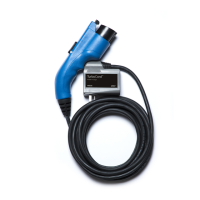3
These commodities, technology or software were exported from the United States in accordance
with the Export Administration Regulations. Diversion contrary to US law is prohibited.
It is recommended that electrical outlets for use with your
charger be installed by a licensed, qualified electrician. To
avoid serious injury or death, installation must comply with
the provisions of the National Electric Code (NEC) and all
local codes. In cases of conflict between local codes and the
NEC, local codes shall take precedence.
WARNING
Improper connection of the electrical outlet grounding
conductor might result in a risk of electric shock. Check with
a qualified electrician if you are uncertain whether or not
the electrical outlet is properly grounded. Do not modify the
plug provided with the product if it does not fit in the outlet.
Have a proper outlet installed by a qualified electrician.
WARNING
WARNING
This product must be grounded. If it should malfunction or
break down, grounding provides a path of least resistance
for electric current to reduce the risk of electric shock.
This product is equipped with a cord having an equipment
grounding conductor and a grounding plug. The plug
must be inserted into an appropriate outlet that is properly
installed and grounded in accordance with all local codes
and ordinances.
ABOUT YOUR TURBOCORD CHARGER
Thank you for purchasing the TurboCord Charger – our easy-to-use, compact, and
portable power supply for your electric vehicle’s on-board charger. The charger supplies
and manages AC power to your electric vehicle and is compatible with a variety of battery
electric and plug-in hybrid electric vehicles.
The charger operates from a 208/240 VAC 60 hertz power source.
Key Features
• Compact, portable design
• Overheating protection
• Quick-read status indicators
• Underwriters Laboratories (UL) listed
• SAE J1772 compliant
• Auto-restart in the event of ground fault or power outage
240VAC Operation: the charger requires either a 240 VAC split phase or a 208 VAC two
phase dedicated circuit. It draws a maximum of 16 amps continuous current and requires a
20 amps rated circuit breaker.

